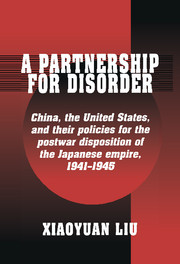 A Partnership for Disorder
A Partnership for Disorder Published online by Cambridge University Press: 20 October 2009
Once both the Chinese and American governments accepted the dismemberment of the Japanese Empire as a logical result of the war, the next question was how to treat Japan's imperial territorial possessions. An answer, also seemingly logical, was that those territories seized by Japan from China should be returned. Thus, China's nationalist objective of recovering lost territories and America's wartime policy of promoting China's international status could both be satisfied. By the time of World War II, China's lost territories were not limited to those seized by Japan, such as Manchuria, Taiwan, and the Ryukyu Islands. It was simply politically expedient for the Allies to focus their postwar plans on the territories in Japan's possession lest other territorial issues cause inter-Allied disunity. Yet, even in the areas just mentioned, the Chinese and the American governments did not readily agree.
Manchuria
To the Chinese government, Manchuria held a unique place in China's rehabilitation. It symbolized China's territorial disintegration in the prewar years due to the fact that, after establishing itself in Nanjing in 1928, Chiang Kai-shek's “central government” had never been able to extend its actual control to the region. During the Sino–Japanese conflict in the 1930s, although it gradually ceased reproving Western treaty powers in China in order to win international sympathy, the Chinese government never formally abandoned the objective of recovering its lost territories. Refraining from pressing other treaty powers over territorial problems, the Chinese government's persistent claim to Manchuria became the only evidence that its “revolutionary diplomacy” was still alive.
To save this book to your Kindle, first ensure no-reply@cambridge.org is added to your Approved Personal Document E-mail List under your Personal Document Settings on the Manage Your Content and Devices page of your Amazon account. Then enter the ‘name’ part of your Kindle email address below. Find out more about saving to your Kindle.
Note you can select to save to either the @free.kindle.com or @kindle.com variations. ‘@free.kindle.com’ emails are free but can only be saved to your device when it is connected to wi-fi. ‘@kindle.com’ emails can be delivered even when you are not connected to wi-fi, but note that service fees apply.
Find out more about the Kindle Personal Document Service.
To save content items to your account, please confirm that you agree to abide by our usage policies. If this is the first time you use this feature, you will be asked to authorise Cambridge Core to connect with your account. Find out more about saving content to Dropbox.
To save content items to your account, please confirm that you agree to abide by our usage policies. If this is the first time you use this feature, you will be asked to authorise Cambridge Core to connect with your account. Find out more about saving content to Google Drive.